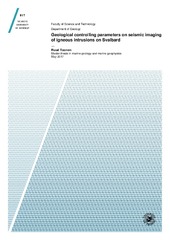| dc.contributor.advisor | Senger, Kim | |
| dc.contributor.author | Toonen, Ruud | |
| dc.date.accessioned | 2018-05-23T12:37:37Z | |
| dc.date.available | 2018-05-23T12:37:37Z | |
| dc.date.issued | 2017-05-15 | |
| dc.description.abstract | Imaging and mapping igneous intrusions such a sills and dykes has been one of the challenges in recent years. However, igneous intrusions in seismic data have properties that make them good targets for visualization, such as high amplitude and sophisticated shapes. 3D visualization methods are especially well suited for sill reflections. One of the main limitations of tying offshore seismic data to onshore observations and vice versa is a matter of scale. Igneous sills that are exposed onshore might be too thin to consistently map in seismic data, whereas features that are visible in seismic surveys offshore might be too long to be able to view onshore. Understanding the geometry of these intrusions may provide key insights regarding emplacement processes, geological history, and potential for hydrocarbon exploration. The research is based on photogrammetric research, analysis of intrusions and their host rocks, and building 3-D models to use for synthetic seismic generation. Well analysis is also required in order to estimate the properties used for these synthetic seismics. Five different geometries have been tested using different lithologies for the host rocks. Sandstone/shale, organic rich shale, clean sandstone and Paleozoic carbonates. The test cases using organic shale show a high impedance contrast, where the cases using carbonates show a very low contrast, due to the similarities of the Vp and Vs with the doleritic intrusions. The sandstone/shale and shale lithologies have more contrast than the carbonates, but less than the organic rich shale. Most shapes show up fairly well on the synthetic data, however sub-vertical geometries have low visibility regardless of the lithology. There are some seismic properties that are hard to simulate using synthetic seismic, such as seismic attenuation, variance of properties within a lithology, and the presence of other geological features. Regardless, the use of synthetic seismic data may help bridge the data integration gap between onshore and offshore data. | en_US |
| dc.identifier.uri | https://hdl.handle.net/10037/12775 | |
| dc.language.iso | eng | en_US |
| dc.publisher | UiT Norges arktiske universitet | en_US |
| dc.publisher | UiT The Arctic University of Norway | en_US |
| dc.rights.accessRights | openAccess | en_US |
| dc.rights.holder | Copyright 2017 The Author(s) | |
| dc.rights.uri | https://creativecommons.org/licenses/by-nc-sa/3.0 | en_US |
| dc.rights | Attribution-NonCommercial-ShareAlike 3.0 Unported (CC BY-NC-SA 3.0) | en_US |
| dc.subject.courseID | GEO-3900 | |
| dc.subject | VDP::Mathematics and natural science: 400::Geosciences: 450::Petroleum geology and petroleum geophysics: 464 | en_US |
| dc.subject | VDP::Matematikk og Naturvitenskap: 400::Geofag: 450::Petroleumsgeologi og -geofysikk: 464 | en_US |
| dc.title | Geological controlling parameters on seismic imaging of igneous intrusions on Svalbard | en_US |
| dc.type | Master thesis | en_US |
| dc.type | Mastergradsoppgave | en_US |


 English
English norsk
norsk
